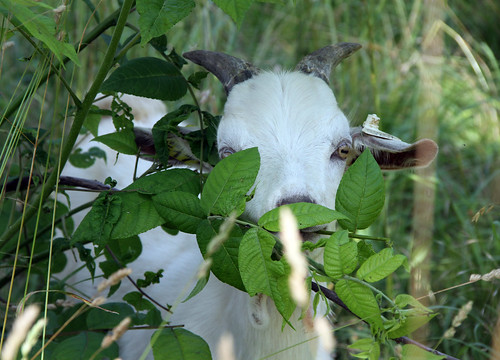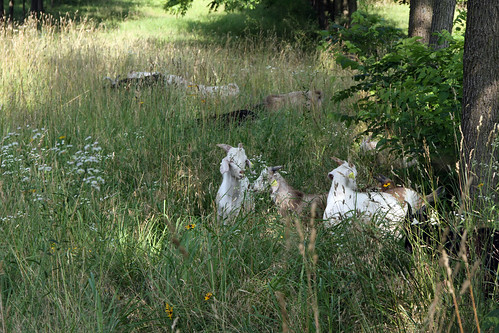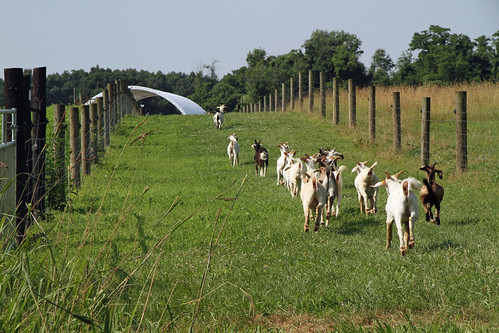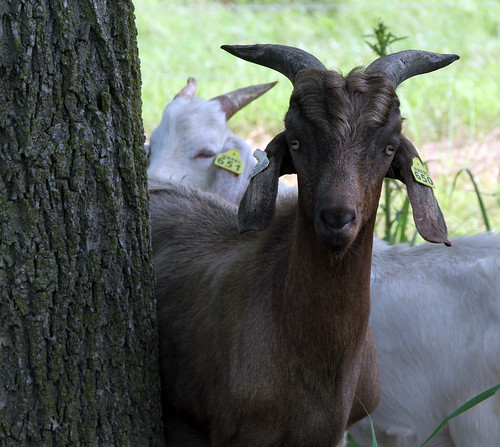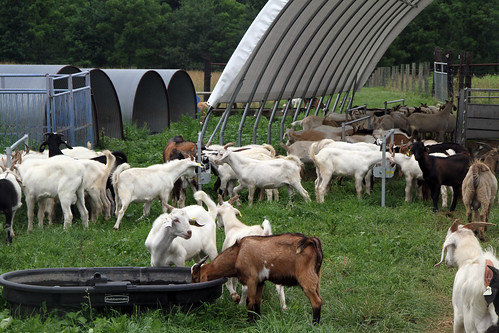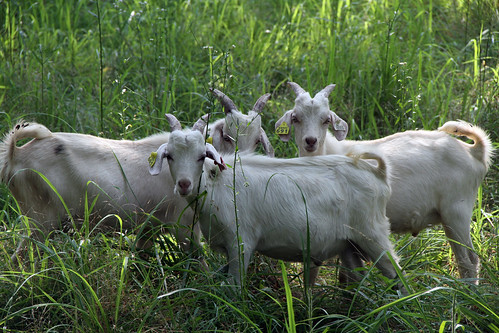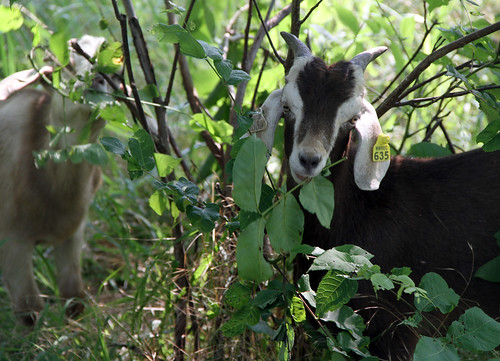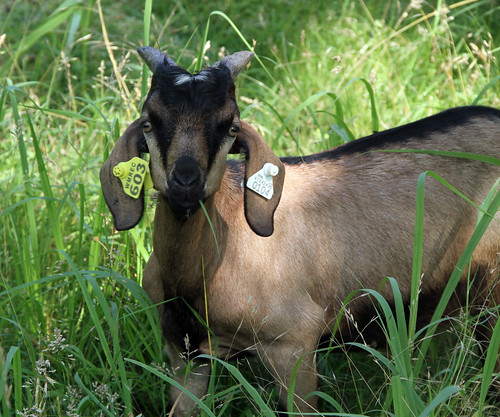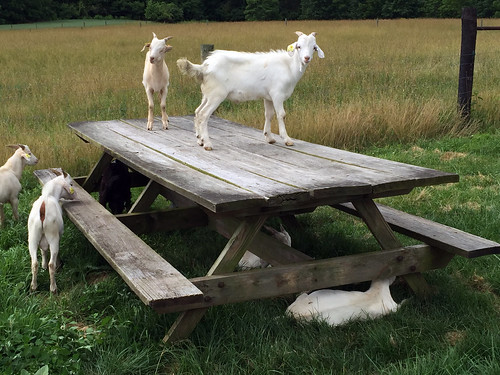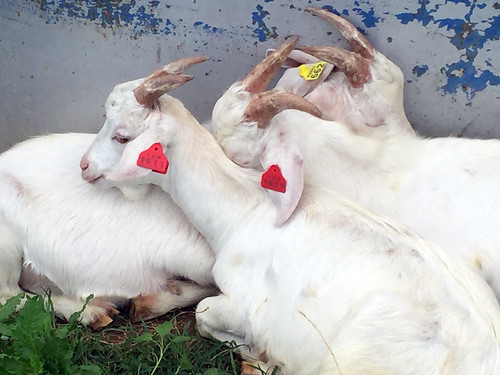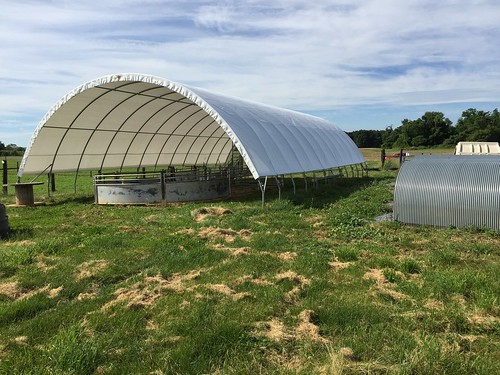Thursday, June 30, 2016
Tuesday, June 28, 2016
West Virginia Buck Test
Several consigners are also participating in West Virginia University's Small Ruminant Evaluation Program. The location of the test is the WVU Animal Science Farm in Morgantown.
The bucks were delivered to the test site on May 14. The test began on May 24. While on test, the bucks are fed in a pen; residual feed intake is calculated.
Progress reports will be disseminated at three week intervals and can be accessed on the web at http://sheepandgoats.wvu.edu or via Facebook at https://www.facebook.com/wvrambucktest.
There will be a sale of qualifying bucks on August 20.
The bucks were delivered to the test site on May 14. The test began on May 24. While on test, the bucks are fed in a pen; residual feed intake is calculated.
Progress reports will be disseminated at three week intervals and can be accessed on the web at http://sheepandgoats.wvu.edu or via Facebook at https://www.facebook.com/wvrambucktest.
There will be a sale of qualifying bucks on August 20.
Sunday, June 26, 2016
The Contest Begins
Fifteen bucks began the Performance & Carcass Contest on June 23-24. Arrival weights ranged from 28.6 to 60.8 lbs. and averaged 47 + 9.9 lbs. The median weight was 46.8 lbs.
The contest goats are housed in a 16 x 16 foot pen, with a three-sided shelter and environmental enrichment. They will be limit fed a diet consisting of a mixed grass-legume hay and whole barley, along with free choice minerals. The goal is moderate growth.
After the 13-day adjustment period, starting weights will be determined on July 7-8. The contest goats will be weighed every four weeks. They will be harvested soon after final weights are determined on September 30.
Download June 23-24 Contest Report, d (-13)
The contest goats are housed in a 16 x 16 foot pen, with a three-sided shelter and environmental enrichment. They will be limit fed a diet consisting of a mixed grass-legume hay and whole barley, along with free choice minerals. The goal is moderate growth.
 |
| Being introduced to barley |
After the 13-day adjustment period, starting weights will be determined on July 7-8. The contest goats will be weighed every four weeks. They will be harvested soon after final weights are determined on September 30.
Download June 23-24 Contest Report, d (-13)
Saturday, June 25, 2016
Adjustment Period
Ninety-seven (97) bucks were delivered to the test site on June 23 and 24. Delivery weights ranged from 32.6 to 79.2 lbs. and averaged 47.6 + 9.1 lbs. Nineteen bucks (19.6 percent) failed to meet the minimum weight requirements (of 40 lbs). Four were below 35 lbs. Three exceeded the maximum weight requirement (of 70 lbs). The median weight was 45.8 lbs.
Upon arrival, all goats were sequentially dewormed with albendazole (Valbazen® @ 2 ml/25 lb), moxidectin (Cydectin® @ 4.5 ml/25 lb) and levamisole (Prohibit® @ 3 ml of concentrated drench per 50 lbs). FAMACHA© scores ranged from 1 to 5 and averaged 1.9 + 0.8. The median FAMACHA© score was 2. Only three goats had FAMACHA© scores > 4.
In the future, goats with FAMACHA© scores of 1 and 2 will not be dewormed, whereas goats with FAMACHA© scores of 4 or 5 will be dewormed. Goats with FAMACHA© scores of 3 may or not be dewormed, depending upon the criteria of the Five Point Check© and other factors, such as fecal egg count (2 weeks ago), weight loss (> 0.1 lbs), percent of FAMACHA© 4s and 5s (in herd), and trends in scoring.
In addition to FAMACHA© score (#1), the Five Point Check© includes jaw (#2, bottle jaw), back (#3, body condition score), tail (#4, dag score), and coat condition (#5). Upon arrival and every two weeks, the goats will be evaluated for these criteria.
Upon arrival, no goat had bottle jaw. In the test, a scale of 1 to 5 is used to assess body condition. 1 is an emaciated goat, whereas 5 is an obese goat. A score of 2.5 represents an average body condition score. Body condition scores ranged from 1.5 to 3.0 and averaged 2.2 + 0.3. The median body condition score was 2.
The condition of a goat's hair coat can be indicative of its overall health and thriftiness. Coat condition scores range from 1 to 3, with 1 representing a poor quality hair coat , 2 being average, and 3 being a shiny, smooth hair coat. Coat condition scores ranged from 1.5 to 2.5 and averaged 2.1. The median score was 2.
Dags is originally a sheep term, literally meaning the matted wool on the sheep's backside, usually due to diarrhea (scours). In goats, we look for fecal soiling on the tail, legs, and hocks. Scores range from 0 to 5, with 0 representing no fecal soiling and 5 representing a completed covered backside (very nasty!). Dag scores ranged from 0 to 1. The median score was 0. Most backsides were clean and free from fecal soiling.
Because the dag score is not always indicative of current scouring, we also evaluate fecal consistency. A fecal consistency score of 1 represents normal fecal pellets, whereas a score of 4 is liquid feces (diarrhea). Fecal consistency scores ranged from 1 to 3 and averaged 1.1 + 0.4. The median score was 1. Only a few goats had scours. We tend to see scours in the goats as their diets change, as we rotate them among different paddocks and forage-types. Rainfall will also have a big effect on fecal consistency.
Fecal samples (2-4 g) were obtained from the rectum of each goat. Samples were not obtained from six goats. Once the test starts, two attempts will be made to obtain a fecal sample from an individual goat. If there is no fecal sample when the goat is scored, it will be recycled through the handling system and a second attempt will be made.
Fecal egg counts are a measure of parasite resistance. They will be determined for each goat on a bi-weekly basis. The fecal egg counts from June 23-24 will be compared to the July 7 fecal egg counts to determine the effectiveness of the sequential deworming. A successful treatment will have reduced worm egg counts by 95 percent or more. The purpose of the sequential deworming is to equalize the goats by reducing their fecal egg counts to (near) zero. This way differences observed in the test can be attributed to genetics, not environment.
A pooled fecal sampled was collected from random goats. The eggs in the sample will be hatched into larvae to determine which species of worms were present in the goats upon arrival. While tapeworm eggs and coccidia oocysts can be differentiated from roundworm (strongyle-type) eggs, it is not possible to differentiate between the eggs of the barber pole worm (Haemonchus contortus) and the "bankrupt worms" (Tricholostrongyles and Teladorsagia). Fecal egg counts and larvae ID will be done by Dr. Dahlia O'Brien's lab at Virginia State University.
In addition to the weighing, scoring, and deworming, the goats were made to stand in a footbath containing zinc sulfate. The purpose of foot soaking is to prevent hoof problems. An test ear tag was inserted into the ear of each goat, opposite to ear with the scrapie tag. The goats were vaccinated for soremouth (in the ear). In the early part of the test, they will be treated for coccidiosis (in the water). Barley will be introduced gradually as a supplement. Starting weights will be determined on July 7 and 8.
Download June 24 Report
Upon arrival, all goats were sequentially dewormed with albendazole (Valbazen® @ 2 ml/25 lb), moxidectin (Cydectin® @ 4.5 ml/25 lb) and levamisole (Prohibit® @ 3 ml of concentrated drench per 50 lbs). FAMACHA© scores ranged from 1 to 5 and averaged 1.9 + 0.8. The median FAMACHA© score was 2. Only three goats had FAMACHA© scores > 4.
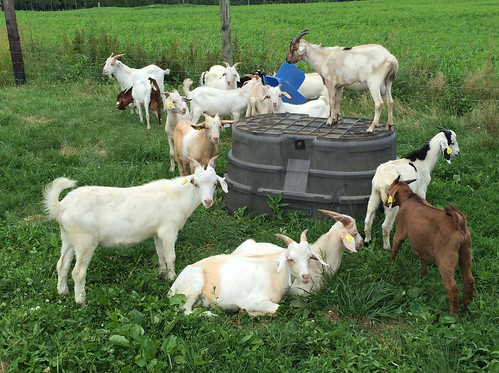 |
| Some of the bucks |
In the future, goats with FAMACHA© scores of 1 and 2 will not be dewormed, whereas goats with FAMACHA© scores of 4 or 5 will be dewormed. Goats with FAMACHA© scores of 3 may or not be dewormed, depending upon the criteria of the Five Point Check© and other factors, such as fecal egg count (2 weeks ago), weight loss (> 0.1 lbs), percent of FAMACHA© 4s and 5s (in herd), and trends in scoring.
In addition to FAMACHA© score (#1), the Five Point Check© includes jaw (#2, bottle jaw), back (#3, body condition score), tail (#4, dag score), and coat condition (#5). Upon arrival and every two weeks, the goats will be evaluated for these criteria.
Upon arrival, no goat had bottle jaw. In the test, a scale of 1 to 5 is used to assess body condition. 1 is an emaciated goat, whereas 5 is an obese goat. A score of 2.5 represents an average body condition score. Body condition scores ranged from 1.5 to 3.0 and averaged 2.2 + 0.3. The median body condition score was 2.
 |
| The working system |
The condition of a goat's hair coat can be indicative of its overall health and thriftiness. Coat condition scores range from 1 to 3, with 1 representing a poor quality hair coat , 2 being average, and 3 being a shiny, smooth hair coat. Coat condition scores ranged from 1.5 to 2.5 and averaged 2.1. The median score was 2.
Dags is originally a sheep term, literally meaning the matted wool on the sheep's backside, usually due to diarrhea (scours). In goats, we look for fecal soiling on the tail, legs, and hocks. Scores range from 0 to 5, with 0 representing no fecal soiling and 5 representing a completed covered backside (very nasty!). Dag scores ranged from 0 to 1. The median score was 0. Most backsides were clean and free from fecal soiling.
Because the dag score is not always indicative of current scouring, we also evaluate fecal consistency. A fecal consistency score of 1 represents normal fecal pellets, whereas a score of 4 is liquid feces (diarrhea). Fecal consistency scores ranged from 1 to 3 and averaged 1.1 + 0.4. The median score was 1. Only a few goats had scours. We tend to see scours in the goats as their diets change, as we rotate them among different paddocks and forage-types. Rainfall will also have a big effect on fecal consistency.
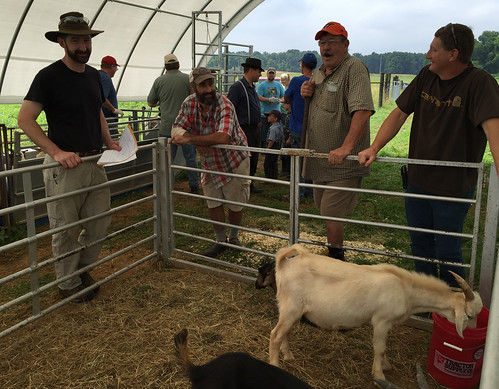 |
| Kiko talk |
Fecal samples (2-4 g) were obtained from the rectum of each goat. Samples were not obtained from six goats. Once the test starts, two attempts will be made to obtain a fecal sample from an individual goat. If there is no fecal sample when the goat is scored, it will be recycled through the handling system and a second attempt will be made.
Fecal egg counts are a measure of parasite resistance. They will be determined for each goat on a bi-weekly basis. The fecal egg counts from June 23-24 will be compared to the July 7 fecal egg counts to determine the effectiveness of the sequential deworming. A successful treatment will have reduced worm egg counts by 95 percent or more. The purpose of the sequential deworming is to equalize the goats by reducing their fecal egg counts to (near) zero. This way differences observed in the test can be attributed to genetics, not environment.
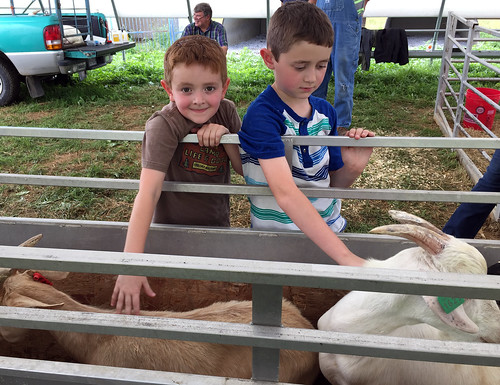 |
| Future consigners |
A pooled fecal sampled was collected from random goats. The eggs in the sample will be hatched into larvae to determine which species of worms were present in the goats upon arrival. While tapeworm eggs and coccidia oocysts can be differentiated from roundworm (strongyle-type) eggs, it is not possible to differentiate between the eggs of the barber pole worm (Haemonchus contortus) and the "bankrupt worms" (Tricholostrongyles and Teladorsagia). Fecal egg counts and larvae ID will be done by Dr. Dahlia O'Brien's lab at Virginia State University.
In addition to the weighing, scoring, and deworming, the goats were made to stand in a footbath containing zinc sulfate. The purpose of foot soaking is to prevent hoof problems. An test ear tag was inserted into the ear of each goat, opposite to ear with the scrapie tag. The goats were vaccinated for soremouth (in the ear). In the early part of the test, they will be treated for coccidiosis (in the water). Barley will be introduced gradually as a supplement. Starting weights will be determined on July 7 and 8.
Download June 24 Report
Thursday, June 23, 2016
Wednesday, June 22, 2016
Ready for Goats
 |
| The annual forages are growing nicely. More rain fell yesterday. |
 |
| We elected not to mow the cool season grass paddocks. |
 |
| The bin is full of whole barley for both the test and contest goats. |
 |
| The contest goats will fed mostly a forage diet, with a similar amount of grain (barley) as the test goats. Test goats that get sick will be fed the same hay. |
Tuesday, June 14, 2016
Getting Ready
In another week, the goats will be delivered to the test site. Today, a new cover was put on the hoop house. The 48' x 30' hoop house covers the handling system and provides a place for the goats to seek shade -- not to mention comfort for goats and people on work days. It is the third cover. The first two covers came off during inclement weather. The new cover is thicker and secured better.
The goal is for the goats to start the test by grazing the five acres of warm seasonal annual grasses and legumes. This year's annual pasture is a mix of BMR pearl millet, Sunn Hemp, cow peas, and brassicas. It was planted almost two weeks ago. There is plenty of moisture to support its fast growth.
This year, the bucks will be supplemented with whole barley (grain). The barley will be gradually introduced to their diet and increased slowly until it reaches a maximum of 1 lb. per head per day. As compared to last year's supplementation with soy hull pellets, barley is a more economical source of energy and far less likely to cause choking among the goats. There is also less likely to be feed wastage, as the soy hull pellets were quite powdery. The barley will be harvested near to the time when the buck test will begin. Barley is grown on the research farm.
Analyses of fecal matter by the Grazingland Animal Nutrition Lab in Texas has shown the test goats' diet to be deficient in energy; thus, the need for energy supplementation. Supplementation also appears to help with parasite resilience, as last year's fecal egg counts were the highest ever, yet few goats showed signs of clinical parasitism (FAMACHA© scores 4, 5).
The contest goats will be penned in a 16 x 16 foot zero-grazing pen with a three-sided shelter. Hay will be fed in four-foot combination hay racks. Grain (whole barley) will be fed once per day in poly troughs that will be hung on side of pen (and removed after feeding). The pen and feeders were cleaned and are ready for arrival of the 16 contest goats.
The goal is for the goats to start the test by grazing the five acres of warm seasonal annual grasses and legumes. This year's annual pasture is a mix of BMR pearl millet, Sunn Hemp, cow peas, and brassicas. It was planted almost two weeks ago. There is plenty of moisture to support its fast growth.
This year, the bucks will be supplemented with whole barley (grain). The barley will be gradually introduced to their diet and increased slowly until it reaches a maximum of 1 lb. per head per day. As compared to last year's supplementation with soy hull pellets, barley is a more economical source of energy and far less likely to cause choking among the goats. There is also less likely to be feed wastage, as the soy hull pellets were quite powdery. The barley will be harvested near to the time when the buck test will begin. Barley is grown on the research farm.
Analyses of fecal matter by the Grazingland Animal Nutrition Lab in Texas has shown the test goats' diet to be deficient in energy; thus, the need for energy supplementation. Supplementation also appears to help with parasite resilience, as last year's fecal egg counts were the highest ever, yet few goats showed signs of clinical parasitism (FAMACHA© scores 4, 5).
The contest goats will be penned in a 16 x 16 foot zero-grazing pen with a three-sided shelter. Hay will be fed in four-foot combination hay racks. Grain (whole barley) will be fed once per day in poly troughs that will be hung on side of pen (and removed after feeding). The pen and feeders were cleaned and are ready for arrival of the 16 contest goats.
Thursday, June 2, 2016
2016 Awards
The consigners with the top-performing buck and top consignment (best three goats) will be awarded a banner. Consigners with bucks in the top-10 will receive rosettes. The top-10 bucks will not be ranked. Awards for the performance and carcass contest will be announced at a later time.
Last year's award winners were Jodie & Randy Majancsik (top-performing buck) and David Peters (top consignment). Other consigners with top-10 bucks included Craig Adams, Brent Ballinger, Jarred Dennison, Darla Dishman/Steve Maynard, Waldo Nelson, P.J. Murphy, and John Weber.
Last year's award winners were Jodie & Randy Majancsik (top-performing buck) and David Peters (top consignment). Other consigners with top-10 bucks included Craig Adams, Brent Ballinger, Jarred Dennison, Darla Dishman/Steve Maynard, Waldo Nelson, P.J. Murphy, and John Weber.
142 Goats Consigned
One hundred and forty-two (142) goats have been nominated by 38 consigners from 17 states. This is the most goats that have ever been consigned to the Western Maryland Pasture-Based Meat Goat Performance Test. While no more consignments are expected, it is still possible to receive consignments in the mail, as the nomination deadline (mail postmark) was June 1.
There are fourteen new consigners and 24 returning consigners. Long-time consigners include John Smith, Virginia (10 years); Kendall & Dana Barnes, Kentucky (9 years); Jarred Dennison, Kentucky (7 years); Waldo Nelson, Maryland (6 years); Wes Pinneo, Kansas (6 years); Mike Renick, West Virginia (5 years); and P.J. Murphy, New Jersey (5 years).
The test capacity has been determined to be 100 goats. Consequently, nominations will have to be reduced. Every effort will be made to include all consigners in this year's test.
Fifteen goats have been entered into the Performance and Carcass Contest. The contest is also at full capacity. No more entries can be accepted.
There are fourteen new consigners and 24 returning consigners. Long-time consigners include John Smith, Virginia (10 years); Kendall & Dana Barnes, Kentucky (9 years); Jarred Dennison, Kentucky (7 years); Waldo Nelson, Maryland (6 years); Wes Pinneo, Kansas (6 years); Mike Renick, West Virginia (5 years); and P.J. Murphy, New Jersey (5 years).
The test capacity has been determined to be 100 goats. Consequently, nominations will have to be reduced. Every effort will be made to include all consigners in this year's test.
State
|
Consigners
|
Test goats
|
Contest goats
|
Alabama
|
3
|
9
|
1
|
Georgia
|
1
|
4
|
0
|
Illinois
|
3
|
10
|
2
|
Indiana
|
1
|
5
|
3
|
Kansas
|
2
|
10
|
2
|
Kentucky
|
7
|
29
|
3
|
Maryland
|
2
|
9
|
0
|
Missouri
|
4
|
12
|
2
|
New Jersey
|
1
|
5
|
0
|
North Carolina
|
4
|
14
|
1
|
Ohio
|
2
|
8
|
1
|
Oklahoma
|
1
|
5
|
0
|
South Carolina
|
1
|
2
|
0
|
Tennessee
|
2
|
5
|
0
|
Vermont
|
2
|
5
|
0
|
Virginia
|
1
|
5
|
1
|
West Virginia
|
1
|
5
|
0
|
Totals
|
38
|
142
|
15
|
Fifteen goats have been entered into the Performance and Carcass Contest. The contest is also at full capacity. No more entries can be accepted.
Wednesday, June 1, 2016
Getting Ready for the Goats
Each year, five acres of the test pasture are planted in annuals. This year's forage mix includes Sunn Hemp, BMR pearl millet, cow peas, rape, and chicory.


In addition, there are five acres of cool season grasses (orchardgrass + MaxQ tall fescue). There is an additional ~2.5 acres of silvopasture. It has the greatest variety of pasture plants. It was left ungrazed by the sheep.

Fresh gravel has been put under the port-a-hut shelters.
The hoop house will provide additional shelter for the goats.

April was a very dry month for the test site. Moisture picked up in May and conditions are good for forage growth.

Subscribe to:
Posts (Atom)

